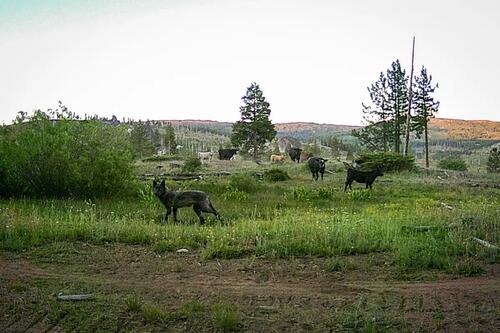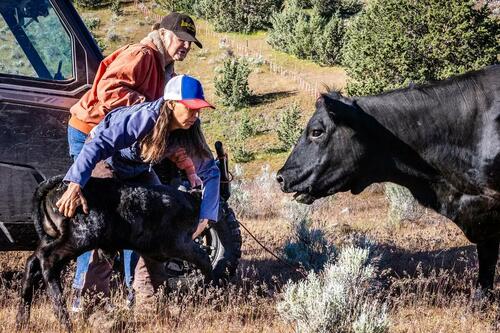Wolves Wreak Havoc On Cattle Herds In California
Authored by Brad Jones via The Epoch Times (emphasis ours),
Descendants of rewilded wolves are taking a heavy toll on cattle in Northern California and Oregon, killing calves and full-grown animals and putting stress on cow-calf operations and ranchers’ pocketbooks.

Because wolves are listed as an endangered species under state and federal law, ranchers are hamstrung: They can’t shoot or harass these protected predators. The penalty for killing a wolf is steep; federal law carries a maximum sentence of one year in prison and a $100,000 fine, unless a rancher can prove that it was in self-defense.
While animal advocacy groups say the wolves are native apex predators that belong in California and other western states, some ranchers argue that there’s nothing natural about wolves’ stalking domestic cattle because there isn’t enough natural prey.
“They’re welfare wolves,” Janna Martin Gliatto, an owner at Table Rock Ranch in northern California, said. “We have entitled wolves—multiple generations.”
One wolf pack, known as the Whaleback Pack, near her ranch doesn’t seem inclined to hunt elk or deer, she said.
Since November 2021, wolves have killed at least 44 head of cattle at the Martin family’s ranch in Siskiyou County, Gliatto told The Epoch Times. Of those confirmed wolf kills, three were adult cows, and the rest were calves.
“There’s a handful of people and ranches like us that have been hit really hard,” she said. “I’ve had so much carnage.”
The protection of wolves has been a “costly experiment” for ranchers and taxpayers who foot the bill for it, Gliatto said.
In 2021, state lawmakers voted to disburse $3 million to the California Department of Fish and Wildlife (CDFW) to develop a pilot program to mitigate the effects of wolves on livestock producers.
The resulting Wolf-Livestock Compensation Program was started in 2022, and by March 2024, the funds were exhausted after 109 claims were paid out to livestock producers for wolf depredation in Siskiyou, Lassen, Plumas, and Tulare counties.
Gliatto received two years of partial compensation to pay a range rider to patrol the herd at night, “but the funds ran out, so now it’s out-of-pocket,” she said.
In 2024, the state appropriated another $600,000 for the CDFW to continue the Wolf-Livestock Compensation Program, but the program no longer subsidizes ranchers for the cost of deterrent efforts such as range riders and is limited to compensation for direct loss only.
CDFW spokeswoman Katie Talbot said California’s wolf population is estimated at between 50 and 70 in total. The agency has confirmed that 163 cattle and six sheep have been killed or injured by wolves since 2011, when the first collared wolf from Oregon entered California, Talbot told The Epoch Times in an email.
She said that of the initial $3 million Wolf-Livestock Compensation Program fund, more than $2 million was paid out for direct loss and deterrence efforts to ranchers in Siskiyou County, while those in Lassen and Plumas counties received about $490,000 and $476,000, respectively. About $16,000 went to Tulare County. Since October 2024, the average compensation per head was $2,870, Talbot said.
Examining Expenses
A recently released study by University of California–Davis professor Tina Saitone, a livestock and rangeland economics specialist, found that one wolf can cause between $69,000 and $162,000 in direct and indirect cattle losses, from outright attacks, lower pregnancy rates in cows, and decreased weight gain in calves.
Saitone’s research team used motion-activated field cameras, GPS collars, wolf scat analysis, and cattle tail-hair samples to show how the expanding protected gray wolf population is affecting cattle operations, “leading to millions of dollars in losses,” according to the study.
The research showed that during the 2022 and 2023 summer seasons, 72 percent of wolf scat samples from the Lassen Pack—in western Lassen and northern Plumas counties—contained cattle DNA. It also found elevated hair cortisol levels in cattle that ranged in areas with wolves, indicating an increase in stress.
Aside from the financial effects, Gliatto said the wolf issue has been emotionally taxing on ranchers who’ve witnessed continual attacks on their herds and “hypocrisy” over what is considered humane treatment of cattle.
Ranchers are afraid to brand their cattle because some animal rights groups view the practice as inhumane, but, she said, “you can have a wolf literally tear your animals apart while they’re alive and eat them, and people just turn a blind eye.”
According to Gliatto, wolves wouldn’t be thriving in the wild without heavily supplementing their diet with cattle, which, in some cases, is their primary food source.
The wolves have created fierce competition at the top of the food chain because there aren’t enough deer and elk to feed them and other predators such as mountain lions, bears, and coyotes, she said.
“We have a huge predator bubble,” Gliatto said.
CDFW reported that there were seven documented wolf packs in California in 2024, along with evidence of other wolves in the state.

The first wolves showed up at Gliatto’s ranch in 2020.
A lone male wolf, OR-85, collared in February 2020, left his natal Mount Emily pack near La Grande, Oregon, crossed into California, and found a mate from another pack from southwestern Oregon. The pair formed the Whaleback Pack and have produced 21 pups since 2021, according to CDFW.
Tracking showed cluster points of OR-85 near an elk herd on ranchland that the family leased, but the pack doesn’t feed on them, Gliatto said.
The elk herd, often spotted at Grass Lake, stopped going there, she said.
“They just moved away from the wolves, and the wolves didn’t follow them,” Gliatto said.
Instead, she said, the wolves have become habituated to preying on cattle at her family’s ranch, which typically has more than 1,500 head, including cow-calf pairs, and replacement heifers.
Table Rock Ranch borders timberland at the forest-edge of a mountain range, so when wolves descend into the valley, her cattle are the first meal they see. Hence, from a wolf’s perspective, it makes no sense to go farther down into the valley, where there are more people and less cover, Gliatto said.
Amaroq Weiss, an attorney and the senior West Coast wolf advocate at the Center for Biological Diversity, said some cattle herds are hit harder than others.
“You constantly have animals that are vulnerable because they’re not being checked on,” she told The Epoch Times. “They’ve eaten poisonous weeds, they’ve gotten wounded for some reason, they’re having birthing complications. All those things are going to draw wolves in.”
Wolves aren’t targeting the closest ranch or the first cattle herd they encounter, and they will often roam through pastures filled with cattle “and just keep on going out the other end of the pasture to hunt wild prey,” Weiss said.
The Whaleback Pack, and some others in California, cover immense territories compared with most wolf packs in other western states that have more elk and deer, because “they’re looking for a food source,” she said.
Siskiyou County wolf liaison Patrick Griffin, who investigates suspected wolf kills for the U.S. Fish and Wildlife Service, said the 44 confirmed kills at Table Rock Ranch “sounds accurate,” noting that it has been the hardest-hit ranch in the state.
More than 80 “confirmed” or “probable” cattle kills have been attributed to the Whaleback Pack, Griffin told The Epoch Times.
Read the rest here…
Tyler Durden Fri, 05/30/2025 – 22:35
Source: https://freedombunker.com/2025/05/30/wolves-wreak-havoc-on-cattle-herds-in-california/
Anyone can join.
Anyone can contribute.
Anyone can become informed about their world.
"United We Stand" Click Here To Create Your Personal Citizen Journalist Account Today, Be Sure To Invite Your Friends.
Before It’s News® is a community of individuals who report on what’s going on around them, from all around the world. Anyone can join. Anyone can contribute. Anyone can become informed about their world. "United We Stand" Click Here To Create Your Personal Citizen Journalist Account Today, Be Sure To Invite Your Friends.
LION'S MANE PRODUCT
Try Our Lion’s Mane WHOLE MIND Nootropic Blend 60 Capsules
Mushrooms are having a moment. One fabulous fungus in particular, lion’s mane, may help improve memory, depression and anxiety symptoms. They are also an excellent source of nutrients that show promise as a therapy for dementia, and other neurodegenerative diseases. If you’re living with anxiety or depression, you may be curious about all the therapy options out there — including the natural ones.Our Lion’s Mane WHOLE MIND Nootropic Blend has been formulated to utilize the potency of Lion’s mane but also include the benefits of four other Highly Beneficial Mushrooms. Synergistically, they work together to Build your health through improving cognitive function and immunity regardless of your age. Our Nootropic not only improves your Cognitive Function and Activates your Immune System, but it benefits growth of Essential Gut Flora, further enhancing your Vitality.
Our Formula includes: Lion’s Mane Mushrooms which Increase Brain Power through nerve growth, lessen anxiety, reduce depression, and improve concentration. Its an excellent adaptogen, promotes sleep and improves immunity. Shiitake Mushrooms which Fight cancer cells and infectious disease, boost the immune system, promotes brain function, and serves as a source of B vitamins. Maitake Mushrooms which regulate blood sugar levels of diabetics, reduce hypertension and boosts the immune system. Reishi Mushrooms which Fight inflammation, liver disease, fatigue, tumor growth and cancer. They Improve skin disorders and soothes digestive problems, stomach ulcers and leaky gut syndrome. Chaga Mushrooms which have anti-aging effects, boost immune function, improve stamina and athletic performance, even act as a natural aphrodisiac, fighting diabetes and improving liver function. Try Our Lion’s Mane WHOLE MIND Nootropic Blend 60 Capsules Today. Be 100% Satisfied or Receive a Full Money Back Guarantee. Order Yours Today by Following This Link.







